Dissertation: CLA Supplementation and Body Composition Analysis
VerifiedAdded on 2022/09/21
|29
|6957
|22
Thesis and Dissertation
AI Summary
This dissertation investigates the effects of Conjugated Linoleic Acid (CLA) supplementation on body composition and health outcomes in both exercise-trained athletes and obese adults without exercise training. The research employs a systematic review of existing literature to address the research question: Does CLA affect body composition and health status in these two groups? The study aims to evaluate whether CLA supplementation improves body composition and facilitates weight loss. The dissertation includes an introduction outlining the background, problem statement, research rationale, hypothesis, and objectives. A comprehensive literature review examines existing research on CLA's impact. The methodology section details the systematic review design, search strategy, inclusion/exclusion criteria, and research approach. The results and discussion section synthesizes the findings, focusing on the key themes of CLA's potential to reduce obesity, improve blood glucose and HDL levels, and enhance cardiovascular and immune function. The conclusion summarizes the findings, acknowledges study limitations, and provides recommendations for future research. The study highlights the need for more primary research to validate the efficacy of CLA supplementation in improving body mass, particularly in exercise-trained athletes, and to address the existing literature gap.
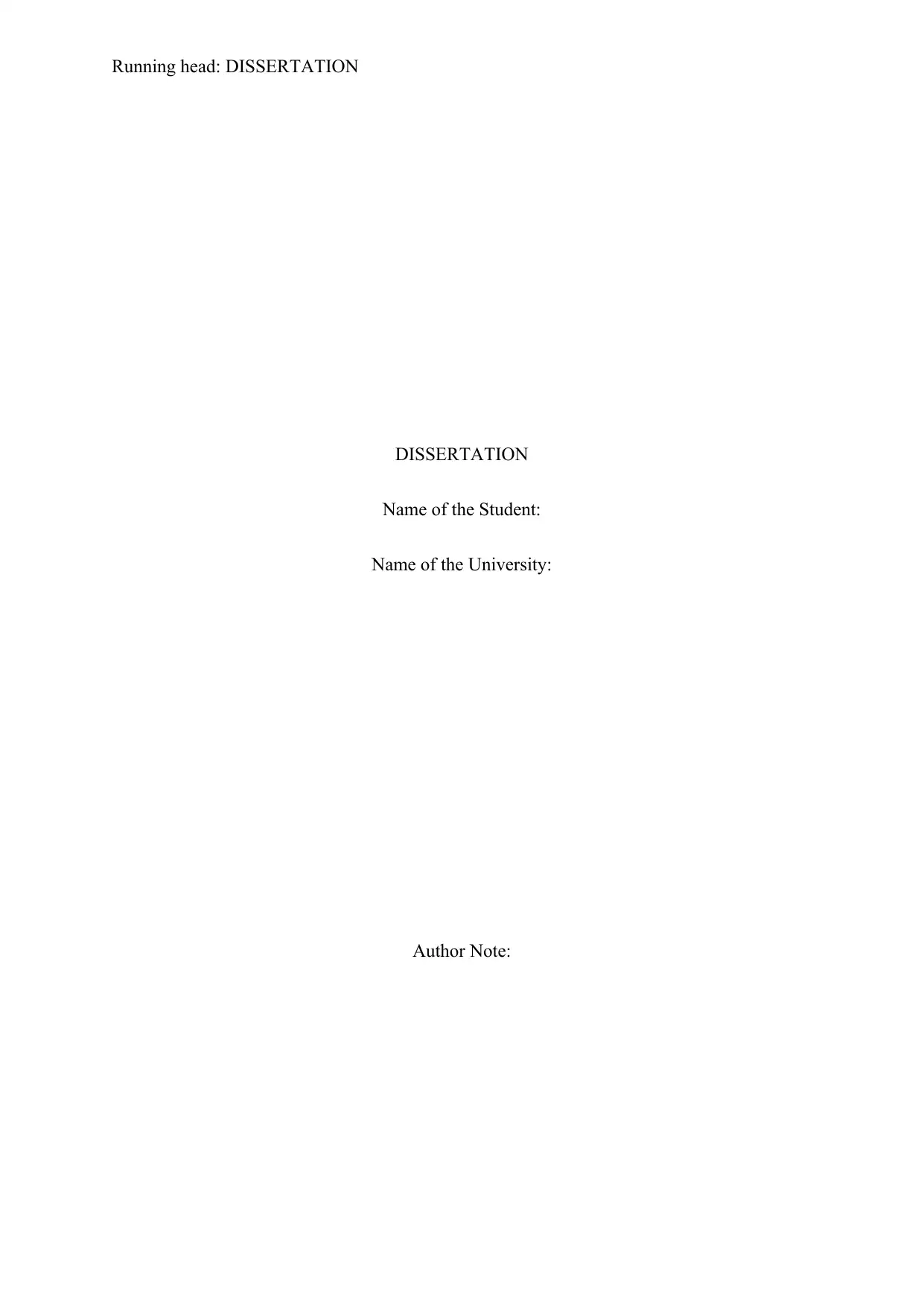
Running head: DISSERTATION
DISSERTATION
Name of the Student:
Name of the University:
Author Note:
DISSERTATION
Name of the Student:
Name of the University:
Author Note:
Paraphrase This Document
Need a fresh take? Get an instant paraphrase of this document with our AI Paraphraser

1DISSERTATION
Abstract:
Background: Conjugated Linoleic Acid or CLA is a popular supplement that finds extensive
use in the fitness industry. The product is widely advertised as a supplement that can
potentially alter the existing body mass and composition. In this regard, it should be noted
that the evidence base reveals a number of animal trials have been conducted on models such
as mice which has yielded positive results. This research study intends to evaluate the
effectiveness of the supplementation on the body mass of exercise trained athletes versus
obese adults without exercise training.
Research Design: A systematic review of the evidence base was conducted in order to
retrieve relevant studies that were aligned to the research question and objectives.
Research Question: Does CLA or Conjugated Linoleic Acid affect the body composition and
health status in athletes and resistance trained individuals?
Research Aim: The aim of the research is to evaluate the evidence base in order to retrieve
that whether or not CLA supplementation can improve body composition and facilitate
weight loss within resistance trained individuals along with those lacking exercise experience
of an obese nature.
Results and Discussion: Overall, the findings of the systematic review generated three key
themes which can be mentioned as CLA supplementation can help to reduce obesity, CLA
supplementation can help to improve blood glucose level and HDL level and CLA
supplementation can help to improve cardiovascular outcome and boost immunity status in
human subjects.
Conclusion: The evidence base does not ideally reveal much about the impact of CLA
supplementation on the improvement of body mass in exercise trained athletes compared to
that of obese human subjects who do not have exercise training. More primary research is
Abstract:
Background: Conjugated Linoleic Acid or CLA is a popular supplement that finds extensive
use in the fitness industry. The product is widely advertised as a supplement that can
potentially alter the existing body mass and composition. In this regard, it should be noted
that the evidence base reveals a number of animal trials have been conducted on models such
as mice which has yielded positive results. This research study intends to evaluate the
effectiveness of the supplementation on the body mass of exercise trained athletes versus
obese adults without exercise training.
Research Design: A systematic review of the evidence base was conducted in order to
retrieve relevant studies that were aligned to the research question and objectives.
Research Question: Does CLA or Conjugated Linoleic Acid affect the body composition and
health status in athletes and resistance trained individuals?
Research Aim: The aim of the research is to evaluate the evidence base in order to retrieve
that whether or not CLA supplementation can improve body composition and facilitate
weight loss within resistance trained individuals along with those lacking exercise experience
of an obese nature.
Results and Discussion: Overall, the findings of the systematic review generated three key
themes which can be mentioned as CLA supplementation can help to reduce obesity, CLA
supplementation can help to improve blood glucose level and HDL level and CLA
supplementation can help to improve cardiovascular outcome and boost immunity status in
human subjects.
Conclusion: The evidence base does not ideally reveal much about the impact of CLA
supplementation on the improvement of body mass in exercise trained athletes compared to
that of obese human subjects who do not have exercise training. More primary research is

2DISSERTATION
required on the effectiveness of the supplementation to back the claim and appropriately
answer the research question.
required on the effectiveness of the supplementation to back the claim and appropriately
answer the research question.
⊘ This is a preview!⊘
Do you want full access?
Subscribe today to unlock all pages.

Trusted by 1+ million students worldwide
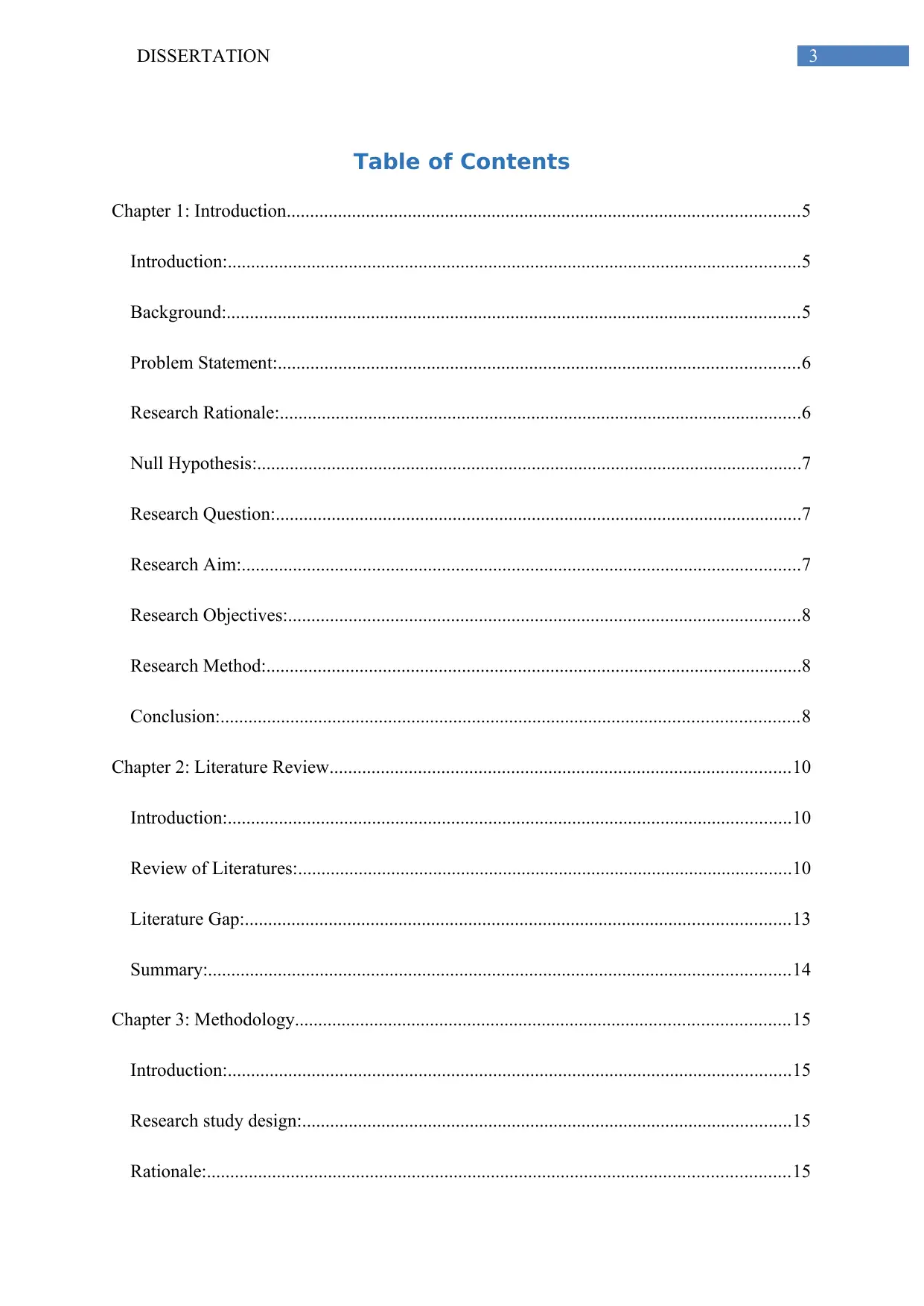
3DISSERTATION
Table of Contents
Chapter 1: Introduction..............................................................................................................5
Introduction:...........................................................................................................................5
Background:...........................................................................................................................5
Problem Statement:................................................................................................................6
Research Rationale:................................................................................................................6
Null Hypothesis:.....................................................................................................................7
Research Question:.................................................................................................................7
Research Aim:........................................................................................................................7
Research Objectives:..............................................................................................................8
Research Method:...................................................................................................................8
Conclusion:............................................................................................................................8
Chapter 2: Literature Review...................................................................................................10
Introduction:.........................................................................................................................10
Review of Literatures:..........................................................................................................10
Literature Gap:.....................................................................................................................13
Summary:.............................................................................................................................14
Chapter 3: Methodology..........................................................................................................15
Introduction:.........................................................................................................................15
Research study design:.........................................................................................................15
Rationale:.............................................................................................................................15
Table of Contents
Chapter 1: Introduction..............................................................................................................5
Introduction:...........................................................................................................................5
Background:...........................................................................................................................5
Problem Statement:................................................................................................................6
Research Rationale:................................................................................................................6
Null Hypothesis:.....................................................................................................................7
Research Question:.................................................................................................................7
Research Aim:........................................................................................................................7
Research Objectives:..............................................................................................................8
Research Method:...................................................................................................................8
Conclusion:............................................................................................................................8
Chapter 2: Literature Review...................................................................................................10
Introduction:.........................................................................................................................10
Review of Literatures:..........................................................................................................10
Literature Gap:.....................................................................................................................13
Summary:.............................................................................................................................14
Chapter 3: Methodology..........................................................................................................15
Introduction:.........................................................................................................................15
Research study design:.........................................................................................................15
Rationale:.............................................................................................................................15
Paraphrase This Document
Need a fresh take? Get an instant paraphrase of this document with our AI Paraphraser
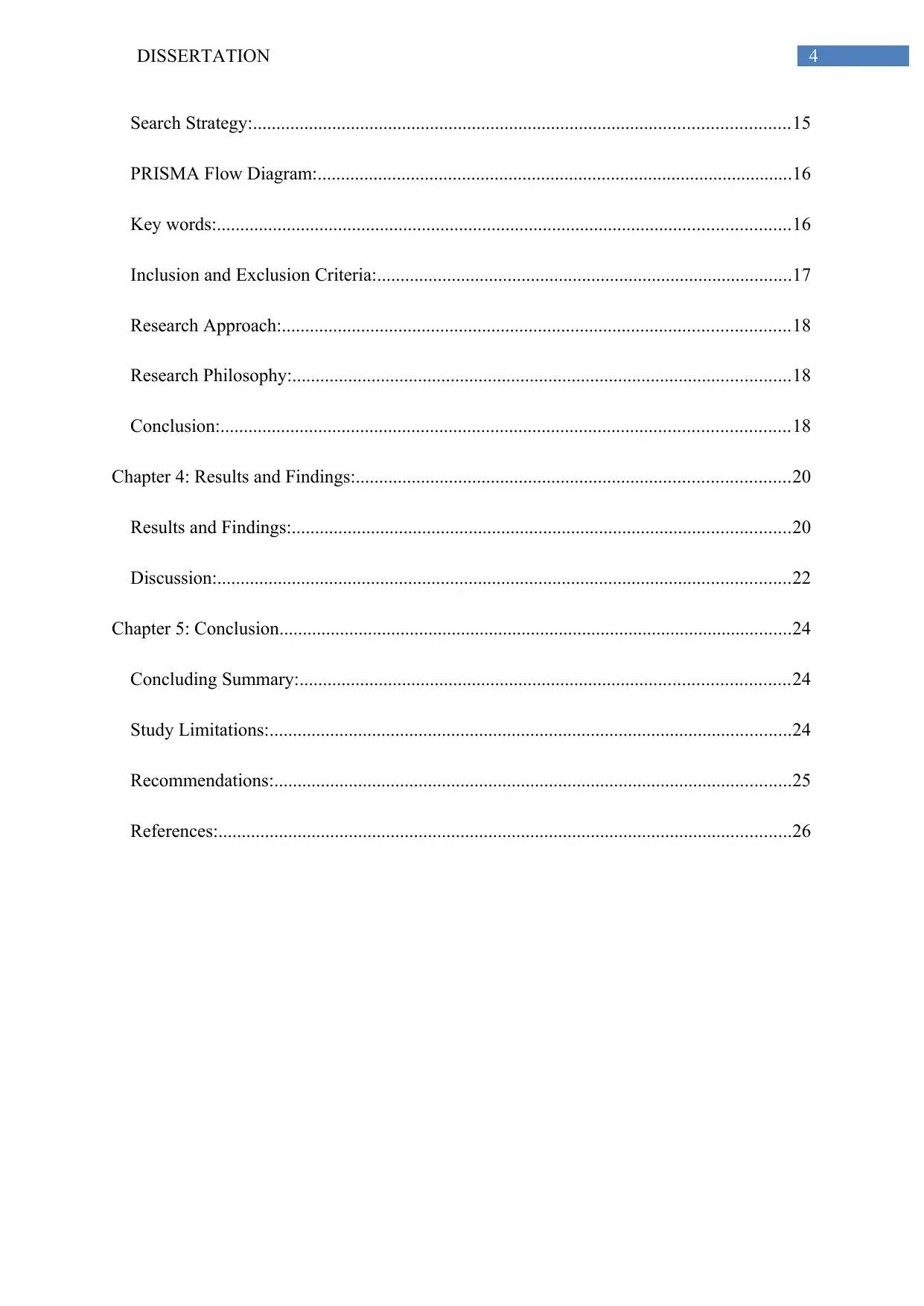
4DISSERTATION
Search Strategy:...................................................................................................................15
PRISMA Flow Diagram:......................................................................................................16
Key words:...........................................................................................................................16
Inclusion and Exclusion Criteria:.........................................................................................17
Research Approach:.............................................................................................................18
Research Philosophy:...........................................................................................................18
Conclusion:..........................................................................................................................18
Chapter 4: Results and Findings:.............................................................................................20
Results and Findings:...........................................................................................................20
Discussion:...........................................................................................................................22
Chapter 5: Conclusion..............................................................................................................24
Concluding Summary:.........................................................................................................24
Study Limitations:................................................................................................................24
Recommendations:...............................................................................................................25
References:...........................................................................................................................26
Search Strategy:...................................................................................................................15
PRISMA Flow Diagram:......................................................................................................16
Key words:...........................................................................................................................16
Inclusion and Exclusion Criteria:.........................................................................................17
Research Approach:.............................................................................................................18
Research Philosophy:...........................................................................................................18
Conclusion:..........................................................................................................................18
Chapter 4: Results and Findings:.............................................................................................20
Results and Findings:...........................................................................................................20
Discussion:...........................................................................................................................22
Chapter 5: Conclusion..............................................................................................................24
Concluding Summary:.........................................................................................................24
Study Limitations:................................................................................................................24
Recommendations:...............................................................................................................25
References:...........................................................................................................................26
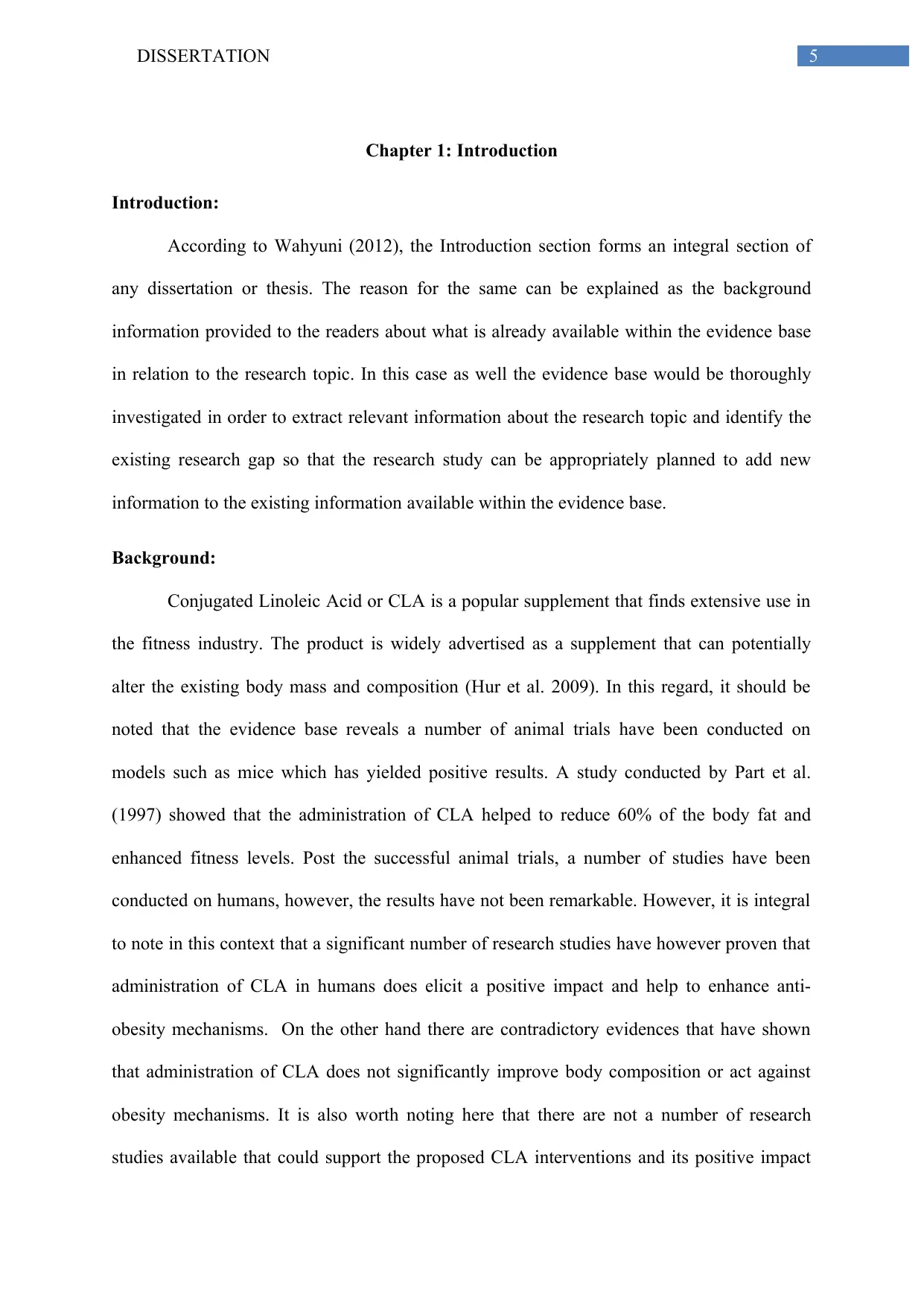
5DISSERTATION
Chapter 1: Introduction
Introduction:
According to Wahyuni (2012), the Introduction section forms an integral section of
any dissertation or thesis. The reason for the same can be explained as the background
information provided to the readers about what is already available within the evidence base
in relation to the research topic. In this case as well the evidence base would be thoroughly
investigated in order to extract relevant information about the research topic and identify the
existing research gap so that the research study can be appropriately planned to add new
information to the existing information available within the evidence base.
Background:
Conjugated Linoleic Acid or CLA is a popular supplement that finds extensive use in
the fitness industry. The product is widely advertised as a supplement that can potentially
alter the existing body mass and composition (Hur et al. 2009). In this regard, it should be
noted that the evidence base reveals a number of animal trials have been conducted on
models such as mice which has yielded positive results. A study conducted by Part et al.
(1997) showed that the administration of CLA helped to reduce 60% of the body fat and
enhanced fitness levels. Post the successful animal trials, a number of studies have been
conducted on humans, however, the results have not been remarkable. However, it is integral
to note in this context that a significant number of research studies have however proven that
administration of CLA in humans does elicit a positive impact and help to enhance anti-
obesity mechanisms. On the other hand there are contradictory evidences that have shown
that administration of CLA does not significantly improve body composition or act against
obesity mechanisms. It is also worth noting here that there are not a number of research
studies available that could support the proposed CLA interventions and its positive impact
Chapter 1: Introduction
Introduction:
According to Wahyuni (2012), the Introduction section forms an integral section of
any dissertation or thesis. The reason for the same can be explained as the background
information provided to the readers about what is already available within the evidence base
in relation to the research topic. In this case as well the evidence base would be thoroughly
investigated in order to extract relevant information about the research topic and identify the
existing research gap so that the research study can be appropriately planned to add new
information to the existing information available within the evidence base.
Background:
Conjugated Linoleic Acid or CLA is a popular supplement that finds extensive use in
the fitness industry. The product is widely advertised as a supplement that can potentially
alter the existing body mass and composition (Hur et al. 2009). In this regard, it should be
noted that the evidence base reveals a number of animal trials have been conducted on
models such as mice which has yielded positive results. A study conducted by Part et al.
(1997) showed that the administration of CLA helped to reduce 60% of the body fat and
enhanced fitness levels. Post the successful animal trials, a number of studies have been
conducted on humans, however, the results have not been remarkable. However, it is integral
to note in this context that a significant number of research studies have however proven that
administration of CLA in humans does elicit a positive impact and help to enhance anti-
obesity mechanisms. On the other hand there are contradictory evidences that have shown
that administration of CLA does not significantly improve body composition or act against
obesity mechanisms. It is also worth noting here that there are not a number of research
studies available that could support the proposed CLA interventions and its positive impact
⊘ This is a preview!⊘
Do you want full access?
Subscribe today to unlock all pages.

Trusted by 1+ million students worldwide
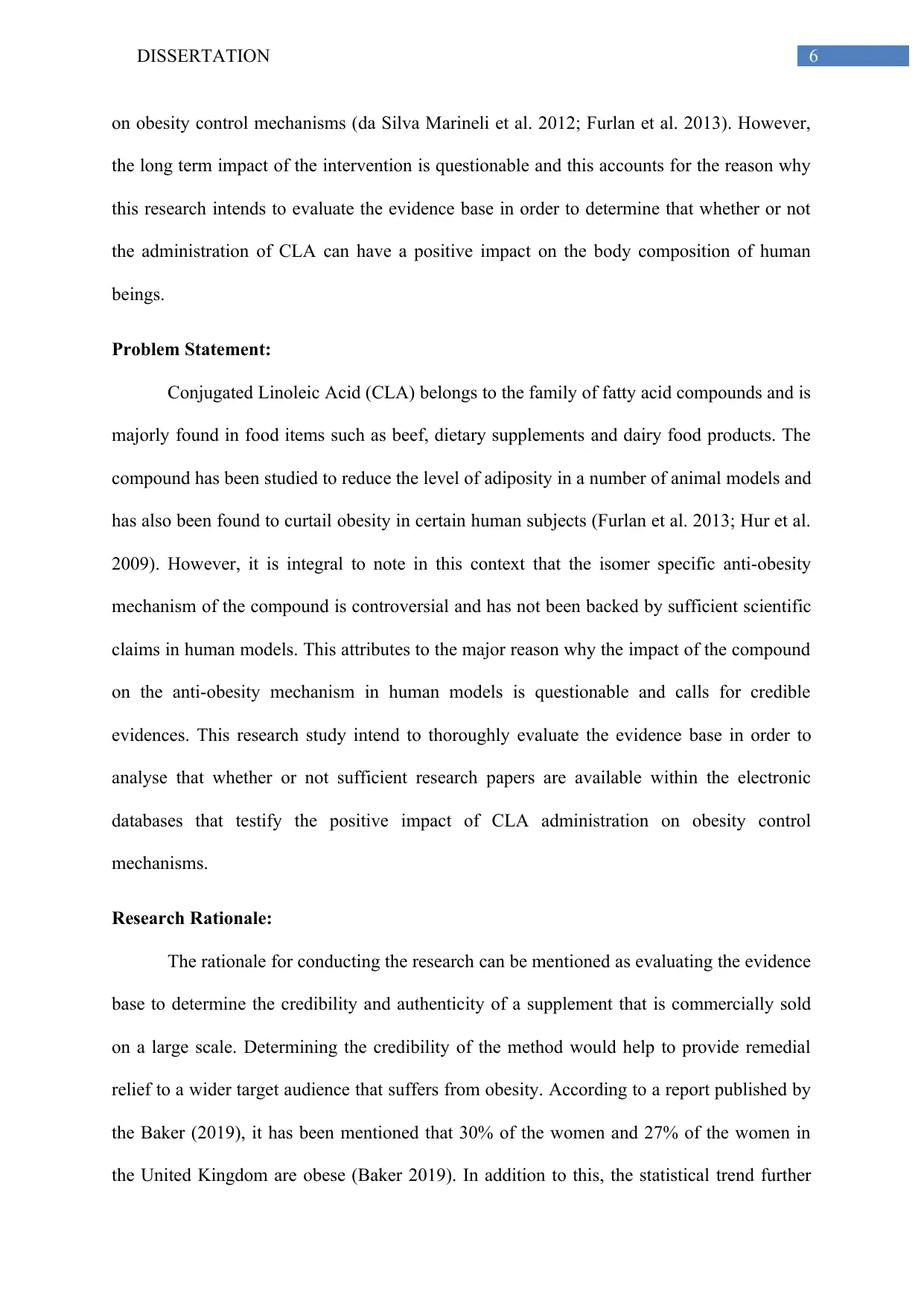
6DISSERTATION
on obesity control mechanisms (da Silva Marineli et al. 2012; Furlan et al. 2013). However,
the long term impact of the intervention is questionable and this accounts for the reason why
this research intends to evaluate the evidence base in order to determine that whether or not
the administration of CLA can have a positive impact on the body composition of human
beings.
Problem Statement:
Conjugated Linoleic Acid (CLA) belongs to the family of fatty acid compounds and is
majorly found in food items such as beef, dietary supplements and dairy food products. The
compound has been studied to reduce the level of adiposity in a number of animal models and
has also been found to curtail obesity in certain human subjects (Furlan et al. 2013; Hur et al.
2009). However, it is integral to note in this context that the isomer specific anti-obesity
mechanism of the compound is controversial and has not been backed by sufficient scientific
claims in human models. This attributes to the major reason why the impact of the compound
on the anti-obesity mechanism in human models is questionable and calls for credible
evidences. This research study intend to thoroughly evaluate the evidence base in order to
analyse that whether or not sufficient research papers are available within the electronic
databases that testify the positive impact of CLA administration on obesity control
mechanisms.
Research Rationale:
The rationale for conducting the research can be mentioned as evaluating the evidence
base to determine the credibility and authenticity of a supplement that is commercially sold
on a large scale. Determining the credibility of the method would help to provide remedial
relief to a wider target audience that suffers from obesity. According to a report published by
the Baker (2019), it has been mentioned that 30% of the women and 27% of the women in
the United Kingdom are obese (Baker 2019). In addition to this, the statistical trend further
on obesity control mechanisms (da Silva Marineli et al. 2012; Furlan et al. 2013). However,
the long term impact of the intervention is questionable and this accounts for the reason why
this research intends to evaluate the evidence base in order to determine that whether or not
the administration of CLA can have a positive impact on the body composition of human
beings.
Problem Statement:
Conjugated Linoleic Acid (CLA) belongs to the family of fatty acid compounds and is
majorly found in food items such as beef, dietary supplements and dairy food products. The
compound has been studied to reduce the level of adiposity in a number of animal models and
has also been found to curtail obesity in certain human subjects (Furlan et al. 2013; Hur et al.
2009). However, it is integral to note in this context that the isomer specific anti-obesity
mechanism of the compound is controversial and has not been backed by sufficient scientific
claims in human models. This attributes to the major reason why the impact of the compound
on the anti-obesity mechanism in human models is questionable and calls for credible
evidences. This research study intend to thoroughly evaluate the evidence base in order to
analyse that whether or not sufficient research papers are available within the electronic
databases that testify the positive impact of CLA administration on obesity control
mechanisms.
Research Rationale:
The rationale for conducting the research can be mentioned as evaluating the evidence
base to determine the credibility and authenticity of a supplement that is commercially sold
on a large scale. Determining the credibility of the method would help to provide remedial
relief to a wider target audience that suffers from obesity. According to a report published by
the Baker (2019), it has been mentioned that 30% of the women and 27% of the women in
the United Kingdom are obese (Baker 2019). In addition to this, the statistical trend further
Paraphrase This Document
Need a fresh take? Get an instant paraphrase of this document with our AI Paraphraser
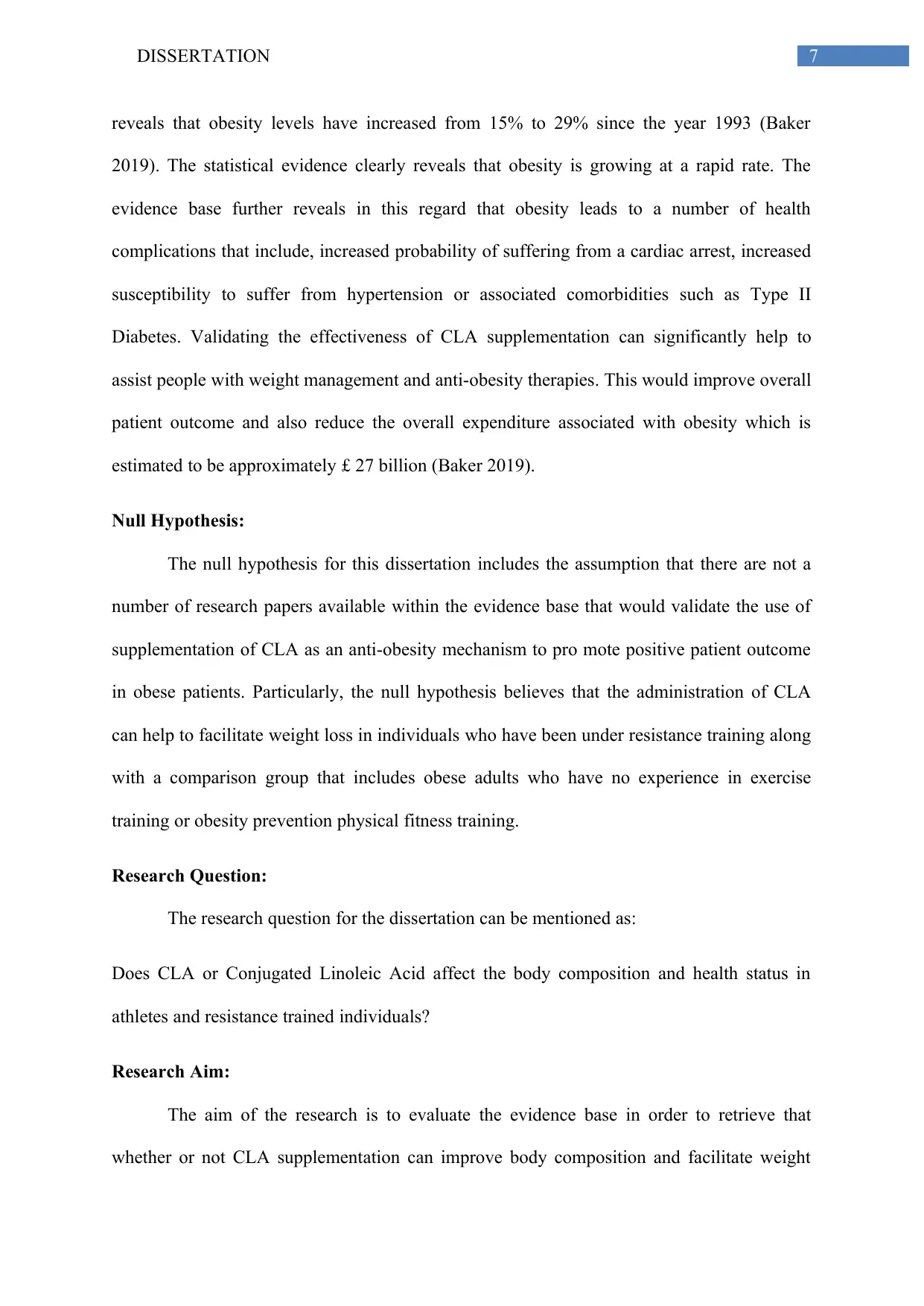
7DISSERTATION
reveals that obesity levels have increased from 15% to 29% since the year 1993 (Baker
2019). The statistical evidence clearly reveals that obesity is growing at a rapid rate. The
evidence base further reveals in this regard that obesity leads to a number of health
complications that include, increased probability of suffering from a cardiac arrest, increased
susceptibility to suffer from hypertension or associated comorbidities such as Type II
Diabetes. Validating the effectiveness of CLA supplementation can significantly help to
assist people with weight management and anti-obesity therapies. This would improve overall
patient outcome and also reduce the overall expenditure associated with obesity which is
estimated to be approximately £ 27 billion (Baker 2019).
Null Hypothesis:
The null hypothesis for this dissertation includes the assumption that there are not a
number of research papers available within the evidence base that would validate the use of
supplementation of CLA as an anti-obesity mechanism to pro mote positive patient outcome
in obese patients. Particularly, the null hypothesis believes that the administration of CLA
can help to facilitate weight loss in individuals who have been under resistance training along
with a comparison group that includes obese adults who have no experience in exercise
training or obesity prevention physical fitness training.
Research Question:
The research question for the dissertation can be mentioned as:
Does CLA or Conjugated Linoleic Acid affect the body composition and health status in
athletes and resistance trained individuals?
Research Aim:
The aim of the research is to evaluate the evidence base in order to retrieve that
whether or not CLA supplementation can improve body composition and facilitate weight
reveals that obesity levels have increased from 15% to 29% since the year 1993 (Baker
2019). The statistical evidence clearly reveals that obesity is growing at a rapid rate. The
evidence base further reveals in this regard that obesity leads to a number of health
complications that include, increased probability of suffering from a cardiac arrest, increased
susceptibility to suffer from hypertension or associated comorbidities such as Type II
Diabetes. Validating the effectiveness of CLA supplementation can significantly help to
assist people with weight management and anti-obesity therapies. This would improve overall
patient outcome and also reduce the overall expenditure associated with obesity which is
estimated to be approximately £ 27 billion (Baker 2019).
Null Hypothesis:
The null hypothesis for this dissertation includes the assumption that there are not a
number of research papers available within the evidence base that would validate the use of
supplementation of CLA as an anti-obesity mechanism to pro mote positive patient outcome
in obese patients. Particularly, the null hypothesis believes that the administration of CLA
can help to facilitate weight loss in individuals who have been under resistance training along
with a comparison group that includes obese adults who have no experience in exercise
training or obesity prevention physical fitness training.
Research Question:
The research question for the dissertation can be mentioned as:
Does CLA or Conjugated Linoleic Acid affect the body composition and health status in
athletes and resistance trained individuals?
Research Aim:
The aim of the research is to evaluate the evidence base in order to retrieve that
whether or not CLA supplementation can improve body composition and facilitate weight

8DISSERTATION
loss within resistance trained individuals along with those lacking exercise experience of an
obese nature.
Research Objectives:
The research objectives for the research would include the following:
To investigate the evidence base in order to evaluate the effectiveness of CLA
supplementation to prevent obesity and ensure weight management
To evaluate the evidence base in order to establish whether or not substantial research
papers are available to support the intervention of CLA supplementation in humans
for obesity prevention
To compare and contrast the impact of CLA supplementation in two groups of
individuals that include exercise trained and resistant obese individuals.
Research Method:
According to Christensen et al. (2011), the choice of an appropriate research method
is integral for the successful completion of the objectives of the dissertation. In addition to
this, it is also extremely important to choose an appropriate research methodology that is
aligned to the articulated research objectives of the research study. In this case, the systematic
review research study design was chosen for addressing the aims and objectives of the
research. The rationale for the same can be explained as the effectiveness of the method to
investigate the evidence base in order to retrieve relevant research papers that help to address
the defined research question (Knobe and Nichols 2013).
Conclusion:
Therefore, to conclude it should be noted that an exhaustive review of the evidence
base would help to retrieve relevant research papers and answer the devised research
loss within resistance trained individuals along with those lacking exercise experience of an
obese nature.
Research Objectives:
The research objectives for the research would include the following:
To investigate the evidence base in order to evaluate the effectiveness of CLA
supplementation to prevent obesity and ensure weight management
To evaluate the evidence base in order to establish whether or not substantial research
papers are available to support the intervention of CLA supplementation in humans
for obesity prevention
To compare and contrast the impact of CLA supplementation in two groups of
individuals that include exercise trained and resistant obese individuals.
Research Method:
According to Christensen et al. (2011), the choice of an appropriate research method
is integral for the successful completion of the objectives of the dissertation. In addition to
this, it is also extremely important to choose an appropriate research methodology that is
aligned to the articulated research objectives of the research study. In this case, the systematic
review research study design was chosen for addressing the aims and objectives of the
research. The rationale for the same can be explained as the effectiveness of the method to
investigate the evidence base in order to retrieve relevant research papers that help to address
the defined research question (Knobe and Nichols 2013).
Conclusion:
Therefore, to conclude it should be noted that an exhaustive review of the evidence
base would help to retrieve relevant research papers and answer the devised research
⊘ This is a preview!⊘
Do you want full access?
Subscribe today to unlock all pages.

Trusted by 1+ million students worldwide

9DISSERTATION
question. This would further help to identify the existing research gap and help future
researchers to conduct future research studies to bridge the existing literature gap.
question. This would further help to identify the existing research gap and help future
researchers to conduct future research studies to bridge the existing literature gap.
Paraphrase This Document
Need a fresh take? Get an instant paraphrase of this document with our AI Paraphraser
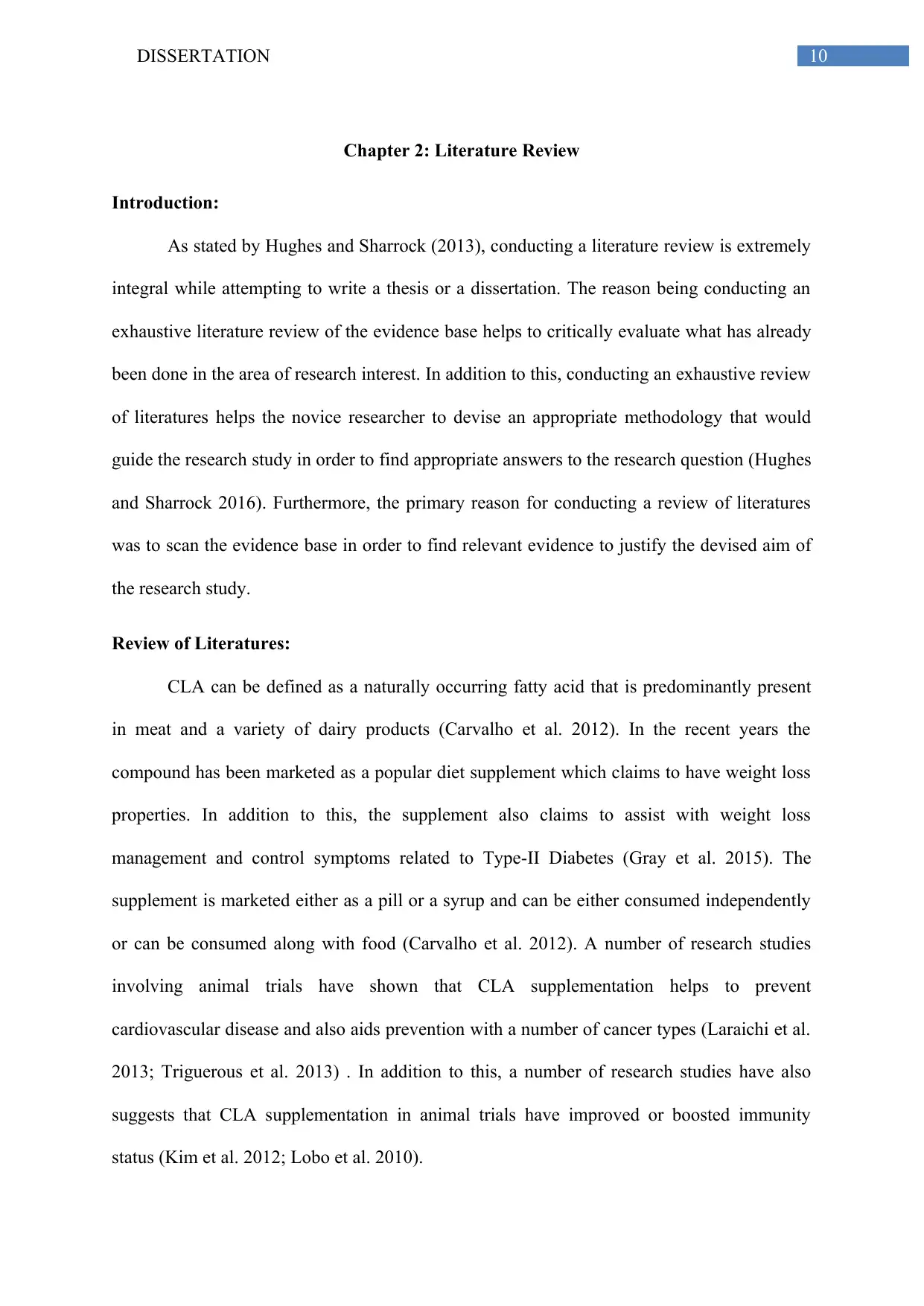
10DISSERTATION
Chapter 2: Literature Review
Introduction:
As stated by Hughes and Sharrock (2013), conducting a literature review is extremely
integral while attempting to write a thesis or a dissertation. The reason being conducting an
exhaustive literature review of the evidence base helps to critically evaluate what has already
been done in the area of research interest. In addition to this, conducting an exhaustive review
of literatures helps the novice researcher to devise an appropriate methodology that would
guide the research study in order to find appropriate answers to the research question (Hughes
and Sharrock 2016). Furthermore, the primary reason for conducting a review of literatures
was to scan the evidence base in order to find relevant evidence to justify the devised aim of
the research study.
Review of Literatures:
CLA can be defined as a naturally occurring fatty acid that is predominantly present
in meat and a variety of dairy products (Carvalho et al. 2012). In the recent years the
compound has been marketed as a popular diet supplement which claims to have weight loss
properties. In addition to this, the supplement also claims to assist with weight loss
management and control symptoms related to Type-II Diabetes (Gray et al. 2015). The
supplement is marketed either as a pill or a syrup and can be either consumed independently
or can be consumed along with food (Carvalho et al. 2012). A number of research studies
involving animal trials have shown that CLA supplementation helps to prevent
cardiovascular disease and also aids prevention with a number of cancer types (Laraichi et al.
2013; Triguerous et al. 2013) . In addition to this, a number of research studies have also
suggests that CLA supplementation in animal trials have improved or boosted immunity
status (Kim et al. 2012; Lobo et al. 2010).
Chapter 2: Literature Review
Introduction:
As stated by Hughes and Sharrock (2013), conducting a literature review is extremely
integral while attempting to write a thesis or a dissertation. The reason being conducting an
exhaustive literature review of the evidence base helps to critically evaluate what has already
been done in the area of research interest. In addition to this, conducting an exhaustive review
of literatures helps the novice researcher to devise an appropriate methodology that would
guide the research study in order to find appropriate answers to the research question (Hughes
and Sharrock 2016). Furthermore, the primary reason for conducting a review of literatures
was to scan the evidence base in order to find relevant evidence to justify the devised aim of
the research study.
Review of Literatures:
CLA can be defined as a naturally occurring fatty acid that is predominantly present
in meat and a variety of dairy products (Carvalho et al. 2012). In the recent years the
compound has been marketed as a popular diet supplement which claims to have weight loss
properties. In addition to this, the supplement also claims to assist with weight loss
management and control symptoms related to Type-II Diabetes (Gray et al. 2015). The
supplement is marketed either as a pill or a syrup and can be either consumed independently
or can be consumed along with food (Carvalho et al. 2012). A number of research studies
involving animal trials have shown that CLA supplementation helps to prevent
cardiovascular disease and also aids prevention with a number of cancer types (Laraichi et al.
2013; Triguerous et al. 2013) . In addition to this, a number of research studies have also
suggests that CLA supplementation in animal trials have improved or boosted immunity
status (Kim et al. 2012; Lobo et al. 2010).
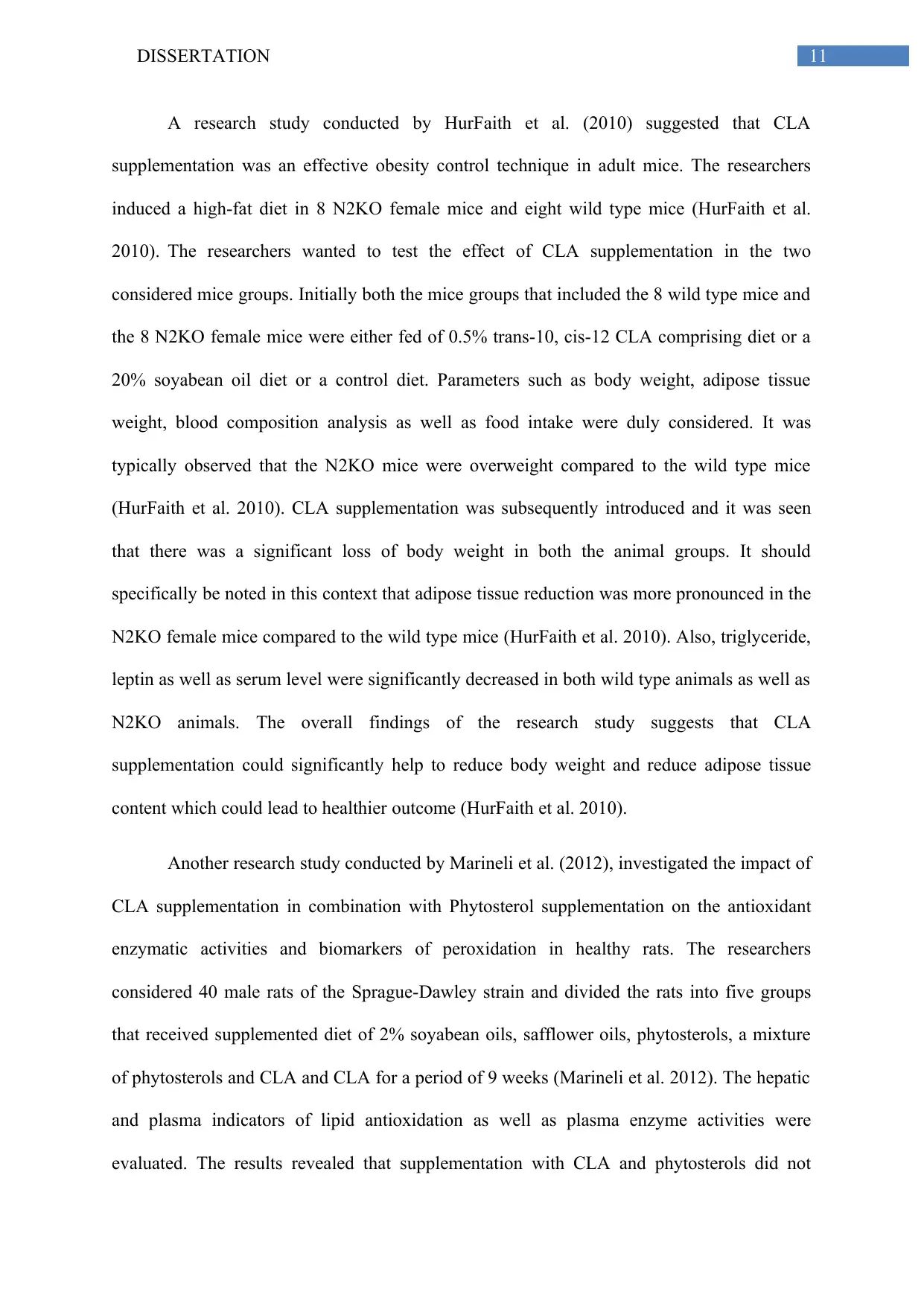
11DISSERTATION
A research study conducted by HurFaith et al. (2010) suggested that CLA
supplementation was an effective obesity control technique in adult mice. The researchers
induced a high-fat diet in 8 N2KO female mice and eight wild type mice (HurFaith et al.
2010). The researchers wanted to test the effect of CLA supplementation in the two
considered mice groups. Initially both the mice groups that included the 8 wild type mice and
the 8 N2KO female mice were either fed of 0.5% trans-10, cis-12 CLA comprising diet or a
20% soyabean oil diet or a control diet. Parameters such as body weight, adipose tissue
weight, blood composition analysis as well as food intake were duly considered. It was
typically observed that the N2KO mice were overweight compared to the wild type mice
(HurFaith et al. 2010). CLA supplementation was subsequently introduced and it was seen
that there was a significant loss of body weight in both the animal groups. It should
specifically be noted in this context that adipose tissue reduction was more pronounced in the
N2KO female mice compared to the wild type mice (HurFaith et al. 2010). Also, triglyceride,
leptin as well as serum level were significantly decreased in both wild type animals as well as
N2KO animals. The overall findings of the research study suggests that CLA
supplementation could significantly help to reduce body weight and reduce adipose tissue
content which could lead to healthier outcome (HurFaith et al. 2010).
Another research study conducted by Marineli et al. (2012), investigated the impact of
CLA supplementation in combination with Phytosterol supplementation on the antioxidant
enzymatic activities and biomarkers of peroxidation in healthy rats. The researchers
considered 40 male rats of the Sprague-Dawley strain and divided the rats into five groups
that received supplemented diet of 2% soyabean oils, safflower oils, phytosterols, a mixture
of phytosterols and CLA and CLA for a period of 9 weeks (Marineli et al. 2012). The hepatic
and plasma indicators of lipid antioxidation as well as plasma enzyme activities were
evaluated. The results revealed that supplementation with CLA and phytosterols did not
A research study conducted by HurFaith et al. (2010) suggested that CLA
supplementation was an effective obesity control technique in adult mice. The researchers
induced a high-fat diet in 8 N2KO female mice and eight wild type mice (HurFaith et al.
2010). The researchers wanted to test the effect of CLA supplementation in the two
considered mice groups. Initially both the mice groups that included the 8 wild type mice and
the 8 N2KO female mice were either fed of 0.5% trans-10, cis-12 CLA comprising diet or a
20% soyabean oil diet or a control diet. Parameters such as body weight, adipose tissue
weight, blood composition analysis as well as food intake were duly considered. It was
typically observed that the N2KO mice were overweight compared to the wild type mice
(HurFaith et al. 2010). CLA supplementation was subsequently introduced and it was seen
that there was a significant loss of body weight in both the animal groups. It should
specifically be noted in this context that adipose tissue reduction was more pronounced in the
N2KO female mice compared to the wild type mice (HurFaith et al. 2010). Also, triglyceride,
leptin as well as serum level were significantly decreased in both wild type animals as well as
N2KO animals. The overall findings of the research study suggests that CLA
supplementation could significantly help to reduce body weight and reduce adipose tissue
content which could lead to healthier outcome (HurFaith et al. 2010).
Another research study conducted by Marineli et al. (2012), investigated the impact of
CLA supplementation in combination with Phytosterol supplementation on the antioxidant
enzymatic activities and biomarkers of peroxidation in healthy rats. The researchers
considered 40 male rats of the Sprague-Dawley strain and divided the rats into five groups
that received supplemented diet of 2% soyabean oils, safflower oils, phytosterols, a mixture
of phytosterols and CLA and CLA for a period of 9 weeks (Marineli et al. 2012). The hepatic
and plasma indicators of lipid antioxidation as well as plasma enzyme activities were
evaluated. The results revealed that supplementation with CLA and phytosterols did not
⊘ This is a preview!⊘
Do you want full access?
Subscribe today to unlock all pages.

Trusted by 1+ million students worldwide
1 out of 29
Related Documents
Your All-in-One AI-Powered Toolkit for Academic Success.
+13062052269
info@desklib.com
Available 24*7 on WhatsApp / Email
![[object Object]](/_next/static/media/star-bottom.7253800d.svg)
Unlock your academic potential
Copyright © 2020–2025 A2Z Services. All Rights Reserved. Developed and managed by ZUCOL.





